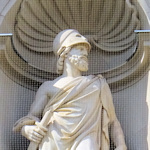
The Kunsthistorisches Museum (KHM) in Vienna appeared as part of the extraordinary burst of construction activity that accompanied the development of the city’s Ringstraßen (Ring boulevard) in the latter part of the nineteenth century.
- Major art museum completed in 1891
- The Natural History Museum opposite is its twin
- Gorgeous lit up at night
- …impressive during the day, too
- Go inside for more beauty
- …both artistic & architectural
- Book KHM tickets* online
- See also:
The building’s history
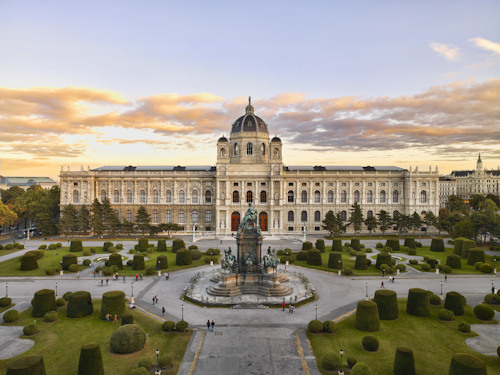
(Kunsthistorisches Museum Wien; press photo © KHM-Museumsverband)
The museum building took 20 years to complete, officially opening in 1891. Its main purpose was to house the art collected by various imperial personalities over the centuries.
Given the interests, wealth, and influence of the Habsburg dynasty, that collection involved an awful lot of paintings, sculptures and the like.
Art of such high calibre deserved a building to match. Unfortunately, the suggestions originally proposed by various architects met with little enthusiasm.

(Building of the domes on the Kunsthistorisches and Naturhistorisches museums around 1881; image from the Michael Frankenstein & Comp. photo studio; Wien Museum Inv.-Nr. 78079/1212/2; excerpt reproduced with permission under the terms of the CC0 licence)
In the end, the museum’s design became dictated within a wider project drawn up with Emperor Franz Joseph’s approval by Gottfried Semper and Karl Freiherr von Hasenauer. The same pair also designed the Burgtheater.
This wider project was the Kaiserforum or Imperial Forum, intended as an impressive complex of buildings and arches spanning the Ring boulevard.
Art and natural history museums formed one part, conceived as mirror images of one another and separated by a landscaped square: Maria-Theresien-Platz.
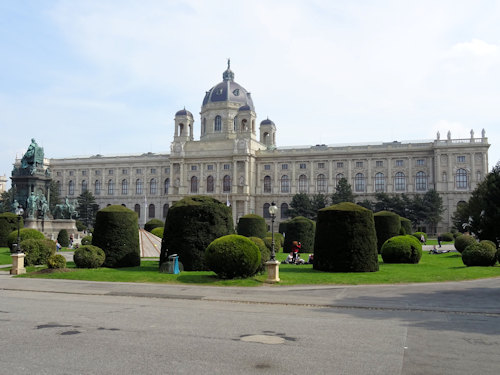
(View across Maria-Theresien-Platz square. The monument on the left features Empress Maria Theresia herself)
Both museums went up according to plan, with the Kunsthistorisches Museum initially opening on Mondays, Wednesdays, and Fridays from 10am to 3pm. And from 9am to 1pm on Sundays.
I should point out that opening hours have changed since then.
The wider forum never reached completion, though. Money proved an issue, as did growing disinterest from the Emperor.
Any chance of finishing the whole monumental project effectively ended with World War I and the subsequent demise of the monarchy; the newly-formed Republic of Austria had other concerns and priorities.
The architecture
The outside of the museum features a series of statues built as the personification of the arts and art history, together with representations of real people: famous artists and their sponsors.
The statues appear chronologically, beginning with the ancients at the back of the building and moving forward in time clockwise.
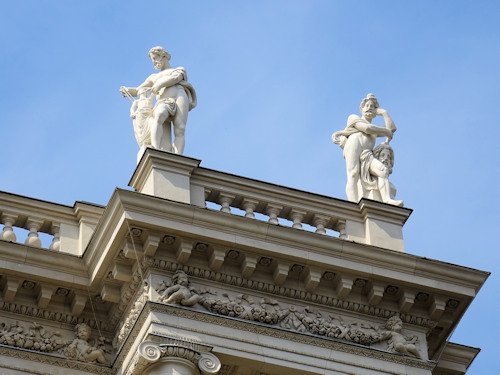
(Two of the rooftop sculptures)
So, for example, at the rear of the building you’ll find Alexander the Great or the Athenian statesman, Pericles. At the front, great centers of Renaissance culture like Venice and statues of artists like Titian, Michelangelo, and Raphael.
The side of the building facing the Ring boasts representations of those modern cities already possessed of great art museums at the time of the KHM’s construction…like London, Paris, Madrid, and Milan.
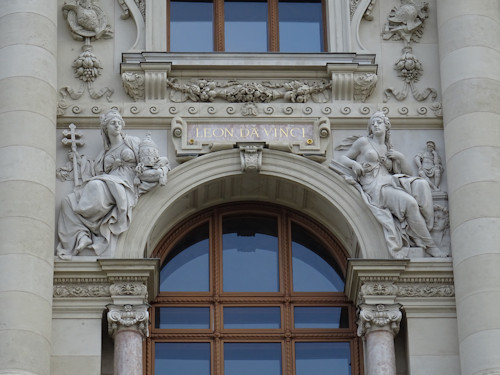
(Leonardo inevitably gets a mention)
Needless to say, the interior of the museum also reflects the splendour of its art collection and the would-be glory of its Imperial sponsor.
A couple of tips for viewing this magnificent building:
- Pop along after dusk and enjoy the lit-up view (see the photo below). During the Christmas season, the market on the square in front of the building adds another layer of lights (and smells, tastes, and sounds).

(Always a lovely nighttime view)
- Drop into the MuseumsQuartier, which is the Kunsthistorisches Museum’s contemporary pendant and neighbour. The free-to-use Libelle viewing platform on top of the Leopold Museum there gives you a view down to the two old museums.
- Stream the movie, Before Sunrise. The museum forms a background location as the two main protagonists wander through Maria-Theresien-Platz.